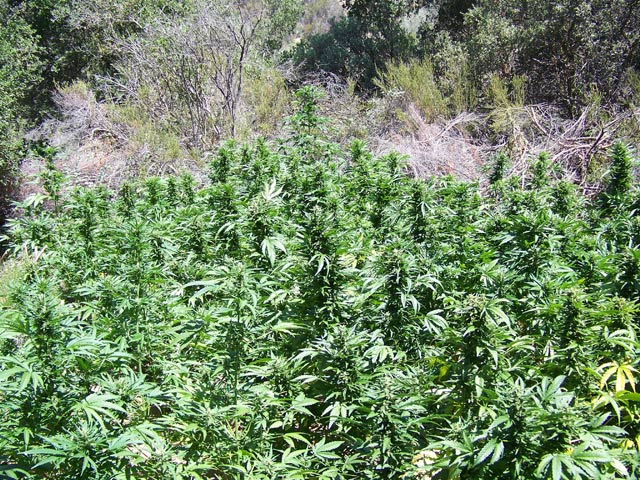Massive Amounts of Marijuana Eradicated from Backcountry Grows
Authorities Confiscated Nearly $30 Million Worth of Adult Plants and Processed Pot

A series of joint operations by the Santa Barbara County Sheriff’s Office and several other agencies raked in nearly $30 million worth of illegal marijuana plants from several sites in the county’s backcountry.
Twenty-five officers from the Sheriff’s Department, California Department of Justice, National Forest Service, and county Search and Rescue cleared out multiple grow sites on National Forest land, removing trash, tents, equipment and almost 12,000 adult cannabis plants, along with 38 pounds of processed marijuana.
Deputies found the mother lode southwest of Cuyama in the Sierra Madre Road area, discovering a large grow site containing approximately 10,500 adult plants. This cash crop provided the bulk of the operation’s numbers — in total, law enforcement secured 11,857 mature plants that DEA officials said were worth up to $29,642,500 on the street.
The Sheriff’s Office reported no arrests during the operation, but officials believe Mexican nationals were living at and tending to several of the grow sites. According to the California Department of Justice Campaign Against Marijuana Production (CAMP), Mexican cartels and other drug organizations have had an increased presence in California marijuana cultivation in order to tap into U.S. markets.
CAMP statistics report the size of typical grow sites have increased drastically over the past decade. In the late 1990s, fields of 3,000 to 5,000 plants were common. By 2003, fields were typically in the 5,000 to 10,000 plant range, with some massive sites containing as many as 30,000 to 40,000. The Sheriff’s Office reports grow sites of this magnitude are not unusual in Santa Barbara County.
Bigger operations and the involvement of Mexican cartels pose a risk to public safety and environmental health in the area, Sheriff’s officials say. Illegal backcountry growers frequently dump trash and various chemicals that can pollute the water supply, as well as damming natural waterways for irrigation, which can harm native vegetation. In fact, investigators determined 2009’s La Brea Fire, which scorched 90,000 acres, originated from a faulty propane tank at an illegal cannabis grow site.
Sheriff’s officials say major sites are often the work of “dangerous drug cartels,” which often secure their sites with dangerous or deadly booby traps and arm their growers, sometimes with high-powered automatic weapons. One loaded 9mm handgun was found at a grow site off East Camino Cielo during the recent eradication.
Law enforcement officials encourage anyone observing suspicious behavior on National Forest land to contact the Sheriff’s Department immediately. Typical red flags include individuals carrying in large amounts of food or irrigation tubing, vehicles parked in the same area multiple times per week or month, new trails or increased use of low-attraction areas, and unusual loss of water flow in creeks.


